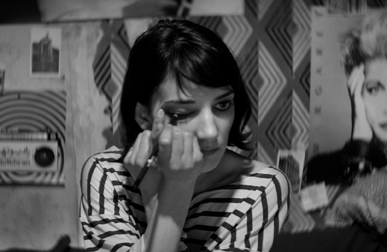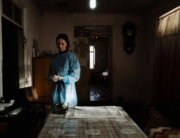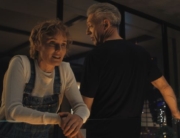The New Directors/New Films series at the Film Society of Lincoln Center and the Museum of Modern Art is a terrific New York City showcase for creative cinema. Not all the best in the 43rd edition of this international feast have yet been picked up for commercial distribution, but nevertheless they deserve to be seen by cinephiles.
There’s been buzz about the opening night selection, A Girl Walks Home Alone at Night, since premiering at Sundance for its startling blending of cinematic influences into an original vision. So wider distribution should be imminent, and debut feature director Ana Lily Amirpour wants her gorgeously Cinemascope film shown in theaters. After all, why should it be difficult to market a black-and-white flick in Farsi by an Iranian-American woman? Amirpour plays on how threatening and conformist the world perceives teens in long black chadors. She makes her very individualistic protagonist, Girl (Sheila Vand) a bat-like vampire by night and by day an adolescent Goth version of the vampire child in the Swedish Let the Right One In.
Girl glides on a skateboard through the dark streets of a desert Bad City, set somewhere once upon a time in the West. (Amirpour calls it a dark fairy tale.) Girl trails prostitutes, addicts, the homeless, and others wallowing in existential bathos in a morally bankrupt landscape, and she shares a taste for American punk with Arash (Arash Marandi), who could be a young Springsteen offering sweet romance down on Thunder Road, but Amirpour’s hip embedding of distinctive leitmotifs for each lonely character is way more hip indie and electronica than classic rock.
But, surprise, the movie is an optimistic ride as he sweetly seduces her to leave this town full of losers, and the audience will be the winner. In expanding her short film, Amirpour storyboarded such a complex backstory for each character that she’s releasing the illustrations in a multivolume graphic novel series, “Death Is the Answer.”
Two Romanian films look keenly at the wrenching impact on families in the past and present when the most realistic hope is to leave the country—for political reasons before the revolution (shot in black and white), and two decades later (in color) for economic motivation.
Set in 1984, Quod Erat Demonstrandum, the second feature by writer/director Andrei Gruzsniczki, examines step by emotionally compromised step how even a geeky guy developing arcane mathematical theorems, professor Sorin Parvu (Sorin Leoveanu), can get caught up in the suffocating maw of restrictions, suspicion, and justifiable paranoia, as security officer Alecu Voican (Florin Piersic Jr.) determinedly investigates him after a paper of his is published in a Western academic journal. Will Sorin’s longtime friendship with a colleague, married to an expatriate, succumb to the insidious collaboration that honeycombs this fatally damaged society? You just want to cry out, “Wait five years, it’ll get better.”
The Japanese Dog opens with images of physical devastation, as the northeastern countryside tries to recover from the 2010 floods that destroyed hundreds of homes and killed dozens, including the wife of retiree Costache (Victor Rebengiuc). Returning from evacuation, he’s methodically pulling out from the muck his ruined belongings and scrounging materials to jerry rig some semblance of normality. Getting the utilities back on is a major negotiation, especially when the mayor is urging him to just sell out his property for development.
For all the films about the struggles of Eastern European immigrants to the west, this is a rare, poignant portrait of those left at home with almost nothing, as it’s eventually revealed when Costache’s construction engineer son, Ticu (Serban Pavlu), comes home for the first time in more than a decade—from Japan, with his Japanese wife and young son who speak no Romanian—for the belated funeral. (The title refers to the boy’s robo-toy.) It’s unusual enough that an under-30-year-old debut director, Tudor Cristian Jurgiu, would allow so much room for an octogenarian actor to give such a magnificent performance. (Claude Berri’s classic The Two of Us comes to mind as a comparison). But even more surprising is that a Romanian film can be so heartwarming.
Two intriguingly queasy films, coincidentally from the uneasy cauldron of the Middle East, reinvigorate genres that Hollywood has beaten to death by adding realistic elements to disturbing stories. Fish & Cat opens with a warning: In 1998, a restaurant in Northern Iran was found to be serving human meat (a real fact)—and the screen goes red. The creepy atmosphere further sets in when the story opens on a pair of seedy, argumentative guys roughly chopping meat outside a deserted café way off the beaten track, where a carful of young folks stop and ask for directions.
Following them deep into a forest preserve, director Shahram Mokri’s perambulations through the brush mesmerize, and we watch with increasing curiosity and alarm—through time, space, sound (natural and electronic score), and from different points of view.
While the college kids gather at a lakeside campground for an annual kite-flying competition—frat boy types and where ex-lovers and friends emotionally confront each other—odd denizens casually appear, like freaky twins and a security guard any girl who has seen a horror movie should know not to trust. But most unsettling, and not gimmicky, is that somehow—up, down, around, far and close up—cinematographer Mahmoud Kalari, a frequent collaborator with Asghar Faradi (A Separation), restlessly films it entirely in a single continuous shot.
The brothers in Youth are obsessed with violent American movies. The younger works at a multiplex and they decorate their suburban Tel Aviv apartment bedroom with movie posters. This is Israel, so when the older one reaches the age for mandatory army service and is issued a rifle, threatening violence for money seems like a logical, if immaturely desperate, solution to family financial problems.
First-time feature director Tom Shoval says he had Hitchcock in mind in how to ratchet up the tension as their kidnapping plot during a weekend leave goes awry in ways both universal and specific to Israeli culture: class, economy, even religious observance, and architecture (a dusty bomb shelter is an ironic reference to distant external threats). At its unnerving core is the tight fraternal relationship between the elder, and dominant, Yaki and his younger brother, Shaul, portrayed by real-life identical twin kibbutzniks Eitan and David Cunio in their acting debut. Their physical and psychological intimacy, from how they wrestle or speak to each other, seems preternatural.







Leave A Comment